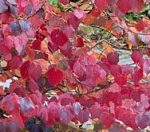
Native to the woodlands of China and Japan, this slender, branched, deciduous shrub is a member of the witch hazel family, Hamamelidaceae, that also includes loropetalum, fothergill, and persian ironwood. Growing up to 10′ tall, it and has blue-green heart-shaped leaves 2-4″ wide that turn dark yellow, orange, red, and purple as temperatures cool. In the fall, plants produce tiny purplish 5-petaled flowers that have are starfish-shaped, 3/4″ wide, andmildly fragrant. The fruit is a 2-lobed capsule containing several glossy black seeds and ripens the following fall. Plants are note worthy for producing good fall color in light shade but should be protected from wind that will damage the foliage. They are a good choice for borders, cottage gardens, and nautalized areas. The genus name, Disanthus, comes from the Greek words dix meaning twice, and anthos meaning flower and refers to the position of the flowers in pairs. The specific epithet, cercidifolius, comes from the genus name of redbuds, Ceris, and the Latin suffix -folius, meaning leaved, and refers to the similarity of redbud leaves to the leaves of this species.
Type: Deciduous shrub
Outstanding Feature: Fall coloration
Form: Spreading
Growth Rate: Slow
Bloom: Tiny, 5-petaled, mildly fragrant, star-shaped, purple flowers in the fall
Size: 6-10′ H x 8-10′ W
Light: Light shade; tolerates less
Soil: Average, consistently moist, well-drained, acidic; does not tolerate dry soil
Hardiness: Zones 5-8
Care: Low maintenance
Pests and Diseases: Generally healthy but may suffer from fungal problems in hot humid climates.
Propagation: Seed, layering in spring